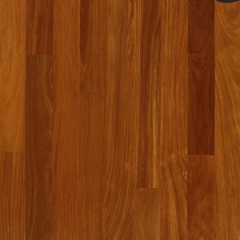Unfinished Exotic Flooring
 Most hardwood brands have expanded their product lines over the past 20 years to include several exotic species. Prior to the early 1990s, teak was the most common exotic hardwood, but in the present, Brazilian cherry has taken its place. In addition to these and other species, most hardwood brands offer prefinished and unfinished exotic flooring for solid and engineered varieties.
Most hardwood brands have expanded their product lines over the past 20 years to include several exotic species. Prior to the early 1990s, teak was the most common exotic hardwood, but in the present, Brazilian cherry has taken its place. In addition to these and other species, most hardwood brands offer prefinished and unfinished exotic flooring for solid and engineered varieties.
Aside from their unusual appearances of darker browns and stronger reds, exotic hardwoods are typically denser than domestic species. On one hand, this quality allows exotic flooring to be more resistant to wear and tear. On the other, it requires more maintenance and makes do-it-yourself installation significantly more difficult. Because the density of these species makes exotic hardwoods harder to cut, hand tools and low-powered saws are often too weak; instead, pneumatic tools are recommended. Additionally, the density contributes to greater weight, making exotic flooring difficult to lift.
Even with these advantages and disadvantages, unfinished exotic flooring allows a homeowner to experiment with various finishes and stains. Some species with distinct appearances, such as tigerwood or Brazilian cherry, may just need a clear finish, however. Staining unfinished exotic flooring, as well, allows it to blend in seamlessly with the rest of the materials in your home.
Aside from Brazilian cherry, other exotic species are commonly found through several brands. These include:
- Amendoim is an exotic hardwood from Argentina, Paraguay, or Brazil that is occasionally called "Brazilian oak."
- Australian Cypress is characterized by visible knots. This exotic hardwood's tongues have tendency to split during installation, however.
- Brazilian Walnut is found in Brazil, Bolivia, Peru, Venezuela, and Guatemala and is one of the most stable hardwoods. With a dark brown shade, Brazilian walnut can shrink when installed into dry areas.
- Kempas and Merbau are exotic hardwoods from Southeast Asia.
- Tigerwood is common in Brazil, Bolivia, Peru, Mexico, and Guatemala and is characterized by a striped appearance of orange-red and dark brown.
- Santos mahogany is a brown to reddish-purple hardwood that may darken over time. The hardwood is found throughout Central and South America.
- Tiete Rosewood is a pinkish-red colored hardwood from South America.
- Brazilian teak is a uniformly-colored brown and tan hardwood found in Brazil, Bolivia, and Peru.
